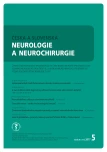Smoking Prevalence in Group of Central-European Patients with Narcolepsy-cataplexy, Narcolepsy without Cataplexy and Idiopathic Hypersomnia
Authors:
P. Peřinová 1; A. Wierzbicka 2; E. Feketeová 3; D. Kemlink 4; P. Kovalská 1; J. Nepožitek 1; V. Ibarburu 1; E. Králíková 5; S. Nevšímalová 1; K. Šonka 1
Authors‘ workplace:
Centrum pro poruchy spánku a bdění, Neurologická klinika a Centrum klinických neurověd 1. LF UK a VFN v Praze
1; Department of Clinical Neurophysiology, Institute of Psychiatry and Neurology, Warsaw, Poland
2; Neurologická klinika LF UPJŠ a UN L. Pasteura Košice
3; Neurologická klinika a Centrum klinických neurověd 1. LF UK a VFN v Praze
4; Centrum pro závislé na tabáku, 3. interní klinika – klinika endokrinologie a metabolizmu 1. LF UK a VFN v Praze
5
Published in:
Cesk Slov Neurol N 2017; 80/113(5): 561-563
Category:
Original Paper
doi:
https://doi.org/10.14735/amcsnn2017561
Overview
Aim:
To map the prevalence of smoking among patients with narcolepsy-cataplexy (NC), narcolepsy without cataplexy (N) and idiopathic hypersomnia (IH) and verify whether smoking prevalence in NC patients is higher than in N and IH patients in Central Europe.
Methods:
We asked 172 adult patients about smoking (111 of them with NC, 37 with N and 24 with IH) using our own structured questionnaire during their outpatient examination or during phone interview.
Results:
Daily smokers represented 46.8% in the NC group, 18.9% in N and 12.5% in the IH group. The prevalence of smoking in the N and IH group together is 16.4%, i.e. significantly lower than the prevalence in the NC group (p = 0.0006, two-sided Fisher test).
Conclusion:
The prevalence of daily smoking among patients with NC is more than twice as high as in the Czech general adult population (18%), and higher than smoking prevalence among N and IH patients together.
Key words:
narcolepsy-cataplexy – narcolepsy without cataplexy – idiopathic hypersomnia – hypocretin/orexin – addiction – smoking – nicotine
The authors declare they have no potential conflicts of interest concerning drugs, products, or services used in the study.
The Editorial Board declares that the manuscript met the ICMJE “uniform requirements” for biomedical papers.
Chinese summary - 摘要
发作性睡病 - 猝倒症、无猝倒嗜睡症和先天性嗜睡症中欧患者的吸烟率目标:
探讨发作性睡病 - 猝倒症(NC),无猝倒嗜睡症(N)和先天性嗜睡症(IH)患者的吸烟情况,并验证中欧地区吸烟率是否是NC组患者高于N组和IH组患者。
方法:
在患者进行门诊检查期间或通过电话访问方式,我们对172名成年患者(111名患有NC,37名患有N,24名患有IH)进行了有关吸烟的结构式问卷调查。
结果:
日常吸烟者在NC组中占46.8%,在N组中占18.9%,在IH组中占12.5%。N组和IH组吸烟率总共为16.4%,显著低于NC组(p = 0.0006,双侧Fisher检验)。
结论:
NC患者每日的吸烟率是捷克普通成年人群(18%)的两倍以上,并高于N和IH患者的总共吸烟率。
关键词:
发作性睡病-猝倒症 - 无猝倒嗜睡症 - 先天性嗜睡症 -下视丘分泌素 /食欲肽 - 成瘾 - 吸烟 - 尼古丁
Sources
1. Ohayon MM, Priest RG, Zulley J, et al. Prevalence of narcolepsy symptomatology and diagnosis in the European general population. Neurology 2002;58(12):1826– 33.
2. Dauvilliers Y, Montplaisir J, Molinari N, et al. Age at onset of narcolepsy in two large populations of patients in France and Quebec. Neurology 2001;57(11):2029– 33.
3. Thannickal TC, Moore RY, Nienhuis R, et al. Reduced number of hypocretin neurons in human narcolepsy. Neuron 2000;27(3):469– 74.
4. Liblau RS, Vassalli A, Seifinejad A, et al. Hypocretin (orexin) biology and the pathophysiology of narcolepsy with cataplexy. Lancet Neurol 2015;14(3):318– 28. doi: 10.1016/ S1474-4422(14)70218-2.
5. Mignot E. Genetic and familial aspects of narcolepsy. Neurology 1998; 50(2 Suppl 1):16– 22.
6. Aran A, Lin L, Nevsimalova S, et al. Elevated anti-streptococcal antibodies in patients with recent narcolepsy onset. Sleep 2009; 32(8):978– 83.
7. Partinen M, Kornum BR, Plazzi G, et al. Narcolepsy as an autoimmune disease: the role of H1N1 infection and vaccination. Lancet Neurol 2014;13(6):600– 13. doi: 10.1016/ S1474-4422(14)70075-4.
8. American Academy of Sleep Medicine. International Classification of Sleep Disorders. 3rd ed. Darien. IL: American Academy of Sleep Medicine 2014.
9. Billiard M, Šonka K. Idiopathic hypersomnia. Sleep Med Rev 2015;29:23– 33. doi: 10.1016/ j.smrv.2015.08. 007.
10. Sovinová H, Csémy L. Užívání tabáku a alkoholu v České republice v roce 2015. Státní zdravotní ústav, Praha. Dostupné z URL: http:/ / www.szu.cz/ uploads/ documents/ czzp/ zavislosti/ Uzivani_tabaku_2015.pdf.
11. Barateau L, Jaussent I, Lopez R, et al. Smoking, alcohol, drug use, abuse and dependence in narcolepsy and idiopathic hypersomnia: a case-control study. Sleep 2016;39(3):573– 80. doi: 10.5665/ sleep.5530.
12. WHO (2008) MPOWER. [online from 2016]. Available in URL: http:/ / www.who.int/ tobacco/ mpower/ en/ .
13. Dimitrova A, Fronczek R, Van der Ploeg J, et al. Reward-seeking behaviour in human narcolepsy. J Clin Sleep Med 2011;7(3):293– 300. doi: 10.5664/ JCSM.1076.
14. von der Goltz C, Koopmann A, Dinter C, et al. Orexin and leptin are associated with nicotine craving: a link between smoking, appetite and reward. Psychoneuroendocrinology 2010;35(4):570– 7. doi: 10.1016/ j.psyneuen.2009.09.005.
15. Kenny PJ. Tobacco dependence, the insular cortex and the hypocretin connection. Pharmacol Biochem Behav 2011;97(4):700– 7. doi: 10.1016/ j.pbb.2010.08.015.
16. Plaza-Zabala A, Flores Á, Martín-García E, et al. A role for hypocretin/ orexin receptor-1 in cue-induced reinstatement of nicotine-seeking behavior. Neuropsychopharmacology 2013;38(9):1724– 36. doi: 10.1038/ npp.2013.72.
17. Boutrel B, Steiner N, Halfon O. The hypocretins and the reward function: what have we learned so far? Front Behav Neurosci 2013;7:59. doi: 10.3389/ fnbeh.2013. 00059.
18. Bayard S, Dauvilliers YA. Reward-based behaviors and emotional processing in human with narcolepsy-cataplexy. Front Behav Neurosci 2013;7:50. doi: 10.3389/ fnbeh.2013.00050.
Labels
Paediatric neurology Neurosurgery NeurologyArticle was published in
Czech and Slovak Neurology and Neurosurgery

2017 Issue 5
Most read in this issue
- Essential Tremor – Is There a New Nosological Concept?
- Leber Hereditary Optic Neuropathy
- Statin-induced Necrotizing Autoimmune Myopathy
- Invasive Methods in the Treatment of Advanced Parkinson’s Disease
